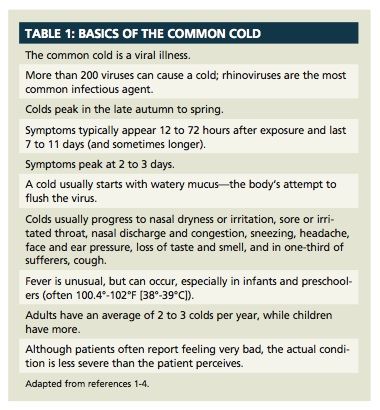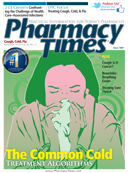Publication
Article
Pharmacy Times
The Common Cold: Treatment Algorithms
Author(s):
Relief is available for common cold symptoms
Relief is available for common cold symptoms.
The cold virus—a human enemy that has been around for centuries—is persistent and annoying. This upper respiratory tract infection is still the same constellation of symptoms—sore throat, nasal congestion, rhinorrhea, cough, fever, and muscle aches and pains1—and to date, no cure exists. Regardless, reviewing the most common treatment algorithms can assist pharmacists in aiding the stream of bleary-eyed, sniffling customers who come to the pharmacy during cold season. Start with a review of the basics in Table 1.1-4
Age Matters
In children and adults, pharmacists usually counsel patients who present with clear symptoms. They should refer patients who have “red flag” symptoms to a physician (Online Table 2).
Symptom relief is the main management strategy, since the common cold is viral and we have no effective treatment. Options include rest, ample hydration, antihistamines, and nasal decongestants.1,5 Patients may need to be reminded to disinfect their environments using phenol-alcohol—based compounds, wash their hands, avoid smoking and alcohol, elevate their heads when sleeping if it helps breathing, and humidify air to soothe nasopharyngeal mucus membranes.1
Kids: Special Concerns
Most patients will want OTC medication for symptoms. Cold and cough medications were among the top 20 substances leading to death in children before 2008, prompting the FDA to require that manufacturers voluntarily relabel these products. Since 2008, these products have had labels that indicate they should not be used in children younger than 4 years. After the labeling change, the number of emergency department (ED) visits related to cough and cold medications (therapeutic errors, unintentional exposures, and adverse drug events) reported in children younger than 2 years halved.6-8 Poison control centers reported decreases in ED visits for older children also.9 An effective alternative to OTC medication for infants with congestion and obstruction is nasal saline drops with bulb-syringe nostril aspiration.1,5

Table 2: The Common Cold: Red Flags Warranting Referral
· Temperature higher than 100.4°F (30°C)
· Chest pain or shortness of breath
· Underlying chronic cardiopulmonary disease
· Symptoms lasting more than 10 days
· Age <9 months or frail patients of advanced age
· Serious symptoms unresponsive to OTC medicines, or new symptoms suggesting complications (eg, otitis media, sinusitis, chronic bronchitis, exacerbations of reactive airway disease)
Adapted from references 1 and 5.
Other Facts
The Online Figure describes treatments and interventions that work. Studies of zinc sulfate show it may decrease symptom duration when it is taken within 24 hours of symptom onset; note that some patients find its taste intolerable and may experience nausea or a loss of taste or smell.10,11
First-generation antihistamines, topical anticholinergics, and ipratropium bromide (available by prescription) reduce rhinorrhea by 25% to 35%.1,12
The Don’ts
No article on colds is complete without a review of ineffective treatments:
• Second-generation (nonsedating) antihistamines are generally ineffective for common cold symptoms.13,14
• Intranasal zinc is not recommended; it can cause permanent damage to sense of smell.15,16
• Echinacea does not appear to reduce a cold’s duration or severity.1,2
• Antibiotics are contraindicated—colds are viral, not bacterial.17
• Codeine does not reduce coughing.18
• Immune-boosting with vitamins and herbs does not seem to prevent colds.19
Endnote
Colds are costly, with patients spending money on treatment, OTC products, and often, useless antibiotics. Colds are also responsible for millions of days of sick leave at work and school. Pharmacists’ best course of action is to help patients self-treat and make rational choices about OTC products when possible and to refer patients when complications are present.
Virginia Bartok is a pharmacist whose primary practice was in indigent care. She currently provides case management for several geriatric patients.
References
1. Fashner J, Ericson K, Werner S. Treatment of the common cold in children and adults. Am Fam Physician. 2012;86:153-159.
2. Singh M. Heated, humidified air for the common cold. Cochrane Database Syst Rev. 2004;(2):CD001728.
3. Heikkinen T, Jarvinen A. The common cold. Lancet. 2003;361:51-59.
4. Arroll B. Non-antibiotic treatments for upper-respiratory tract infections (common cold). Respir Med. 2005;99:1477-1484. www.pharmacylibrary.com/otchandbook. Accessed October 2, 2014.
5. Tietze KJ. Respiratory disorders. In: Krinsky DL, Berardi RR, Ferreri SP, et al, eds. Handbook of Nonprescription Drugs: An Interactive Approach to Self-Care. 17th ed. Washington, DC: American Pharmacists Association; 2011.
6. Bronstein AC, Spyker DA, Cantilena LR Jr, Green JL, Rumack BH, Giffin SL. 2009 annual report of the American Association of Poison Control Centers’ National Poison Data System (NPDS): 27th annual report. Clin Toxicol (Phila). 2010;48:979-1178.
7. FDA releases recommendations regarding use of over-the-counter cough and cold products [news release]. FDA website. www.fda.gov/NewsEvents /Newsroom/PressAnnouncements /2008/ucm116839.htm. Accessed October 2, 2014.
8. Shehab N, Schaefer MK, Kegler SR, Budnitz DS. Adverse events from cough and cold medications after a market withdrawal of products labeled for infants. Pediatrics. 2010;126:1100-1107.
9. Mazer-Amirshahi M, Reid N, van den Anker J, Litovitz T. Effect of cough and cold medication restriction and label changes on pediatric ingestions reported to United States poison centers. J Pediatr. 2013;163:1372-1376.
10. Das RR, Singh M. Oral zinc for the common cold. JAMA. 2014;311:1440-1441.
11. Marshall I. Zinc for the common cold. Cochrane Database Syst Rev. 1999;(2):CD001364.
12. Tran NP, Vickery J, Blaiss MS. Management of rhinitis: allergic and non-allergic. Allergy Asthma Immunol Res. 2011;3:148-156.
13. Berkowitz RB, Tinkelman DG. Evaluation of oral terfenadine for treatment of the common cold. Ann Allergy. 1991;67:593-597.
14. Berkowitz RB, Connell JT, Dietz AJ, Greenstein SM, Tinkelman DG. The effectiveness of the nonsedating antihistamine loratadine plus pseudoephedrine in the symptomatic management of the common cold. Ann Allergy. 1989;63:336-339.
15. Smith WM, Davidson TM, Murphy C. Toxin-induced chemosensory dysfunction: a case series and review. Am J Rhinol Allergy. 2009;23:578-581.
16. D’Cruze H, Arroll B, Kenealy T. Is intranasal zinc effective and safe for the common cold? a systematic review and meta-analysis. J Prim Health Care. 2009;1:134-139.
17. Karsch-Völk M, Barrett B, Kiefer D, Bauer R, Ardjomand-Woelkart K, Linde K. Echinacea for preventing and treating the common cold. Cochrane Database Syst Rev. 2014;2:CD000530.
18. Schroeder K, Fahey T. Over-the-counter medications for acute cough in children and adults in ambulatory settings. Cochrane Database Syst Rev. 2004;(4):CD001831.
19. Kaufman DW, Kelly JP, Rosenberg L, Anderson TE, Mitchell AA. Recent patterns of medication use in the ambulatory adult population of the United States: the Slone survey. JAMA. 2002;287:337-344.







